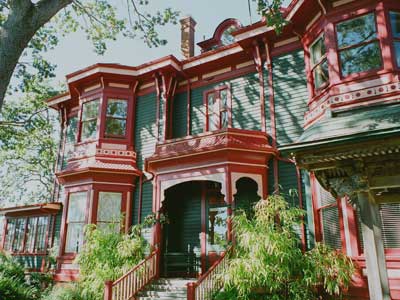Heritage Register
Rockland
1040 Moss Street (ex-17, then 930 Moss St)
Gyppeswyk; Llan Dderwen; Art Gallery of Greater Victoria (AGGV)
Built
1889-90
Heritage-Registered
For: Alexander & Theophilia Green
Architect: William Ridgway Wilson
Contractor: George Mesher & Son

ARCHITECTURE:
This was once a tall, noble multi-hip-roofed Italianate
Villa, standing in a dominant position on the hill, crowned
with stately chimneys and a great rooftop lantern. A porte-cochère
and a conservatory with a tiny octagonal tower on
the front façade are now missing, as is the wrap-around
verandah on the left side and rear. Also gone are the
generous gardens, tennis courts, coach house and stables.
A number of drastic alterations and additions have
been made since 1951 to accommodate the art gallery.
The main entrance, and what was once the porte-cochère
on Moss St, is now a glass-and-concrete gallery lobby;
the pedimented gable over the entrance remains. The
symmetrical garden façade on the left side is still intact,
including a centrally-located palladian dormer on the
roof. A pair of two-storey angled bays are separated by an
angled porch below a balconet, all with sandwich brackets
and other decorative details.
Inside, the impressive, dark-panelled, two-storey
reception hall with its Minton-tiled fireplace and gallery
with Art Nouveau glass is intact. Huge pocket-doors
between the drawing and dining rooms are used to
advantage for events.
Donald Luxton has described William Ridgway-Wilson
as “prolific and surprisingly versatile.” Ridgway-Wilson, who
had only arrived in Victoria in 1887, won the commission to
design this $44,000 house for a prominent local businessman.This doubtless paved the way to such important assignments
as South Park School (508 Douglas St, James Bay) and
Schuhuum (1322 Rockland Av), both 1894.
ORIGINAL OCCUPANTS:
Prominent businessman Alexander Alfred Green (1835-
1891) and his wife Theophila Turner (c.1841-1905) paid
taxes on this property until 1897. Born in Ixworth, England,
Alexander trained as a doctor, but then headed to the gold
fields of Australia, where he reportedly made a considerable
fortune. He went to California, and eventually to Nevada,
where he joined the banking firm of Wells, Fargo & Co. He
came to Victoria as a representative of that firm in 1873.
He called this house Gyppeswyk, the ancient spelling of
Theophila’s birthplace, Ipswich. Green simultaneously
commissioned the domed Green Block, at Broad and
Trounce Alley, later the home of the Victoria Stock
Exchange. Alexander was the founder of the Protestant
Orphans’ Home.
OTHER OCCUPANTS:
When Cary Castle burned, Lieut-Gov T.R. McInnis and his family moved into this house, which was vacant at the time. Rent was paid to Robert Beavan, who paid taxes on the property until 1903, when it was sold to David Spencer. In 1900 a change in Lieutenant-Governors brought Sir Henri Joly de Lotbiniere (1829-1908) to Gyppeswyk with his wife Lady Margaretta Josepha (Gowen, 1837-1904) for nearly three years while the new Government House was constructed. Sir Henry was BC’s Lieutenant-Governor from 1900-06. He was born in France, and arrived in New York on the Robert Kelly in 1850. He married Quebec-born Margaretta in 1856. Sir Henri served as Liberal premier for Quebec briefly in 1878-79, and as a federal cabinet minister 1896-1900 before retiring. In 1901, Sir Henri and Lady de Lotbiniere entertained the Duke and Duchess of Cornwall and York (later King George V and Queen Mary) at this house.
David Spencer (1837-1920) moved in with his family in 1903. David was born in Wales and came to Victoria in 1862. In 1867 he married Emma Lazenby (1842-1934), born in Yorkshire, England, who arrived in Victoria as one of the “bride-ship” women in 1863 on the SS Robert Lowe. For many years they lived at Government and Belleville Sts, where BC Archives is now located. They had 13 children, and three unmarried daughters remained at home – Agnes Evans (1873-1943), Mary Louise (1873-1951) and Sara Ellen (1885-1983). Spencer served as a City alderman in 1871. He was also interested in music and active in the Methodist church, leading the choir, of which his children were members, for many years.
Shortly after his arrival, David bought a small book and stationery business from Charles Hayward, which he sold to Hibben & Carswell. In 1873 he and partner William Denny purchased the retail dry goods firm of Findlay, Durham & Brodie on Government St. Five years later David established his own department store, David Spencer Ltd, which eventually became the largest in Western Canada. The business was originally in the Arcade Block, between Fort St and Trounce Alley. As the business expanded, Spencer bought more property for a 4-storey building designed by Thomas Hooper. This Five Sisters Block was destroyed by fire in 1910. Spencer immediately re-established his business in the old Driard Hotel and the Victoria Theatre, which were converted into a department store in three weeks. Spencer expanded the business in 1907 to Vancouver. He operated the business until his death in 1920, and son Christopher operated the Vancouver branch, and Will (1045 Joan Cr, Rockland) the Victoria one. Daughter Sara took over the Victoria branch in 1946 after Will died, and Timothy Eaton purchased the Spencer business in 1948.
Sara was a noteworthy businesswoman and philanthropist. During WWI she served overseas with the Canadian Field Comforts division and was commissioned as an Honorary Lieutenant. She served many years with various local charitable groups, including Victoria’s Women’s Voluntary Services, the Red Cross and Community Chest Drive. She was president of the Victoria Symphony Society. Sara donated this house to the Art Gallery of Greater Victoria in 1951.
ADDITIONAL INFORMATION & IMAGES:
• Map of Victoria's Heritage Register Properties
• Rockland History
• Rockland Heritage Register
• This Old House, Victoria's Heritage Neighbourhoods,
Volume Three: Rockland, Burnside, Harris Green,
Hillside-Quadra,
North Park & Oaklands

